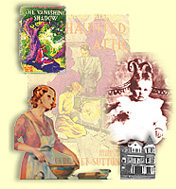
|
The thirty-eight volume Judy Bolton Series was written by Margaret Sutton during the thirtv-five vears spaning from 1932 to 1967. It is without a doubt one of the most successful and enduring girls series ever published. Margaret Sutton Hunting, as she is known now, was born Rachel Irene Beebe in Odin, Pennsylvania, ninety-four ago this past January 22nd. Her father was Victor Beebe, whose well-known History of Potter County is as collectible a book as the hard-to-find Judy Boltons. When she was still a little girl, the family moved to nearby Coudersport where Margaret attended school. She dropped out of high school, being a spirited nonconformist, but furthered her education at The Rochester Business Institute in Rochester, New York and graduated in 1920, then embarked on a career in the business world until she married William H. Sutton in 1924. Margaret was a pen name given to her by her publisher. Later in life, when she was 73, Margaret married Everett Hunting, who had been her brother's college roommate many years before. Everett passed away in 1992, and Margaret is now living in the extended care unit of a hospital in Lock Haven, PA, not far from her native Potter County. The Judy Bolton books are noted not only for the fine plots and thrilling stories, but also for their realism and social commentary. Unlike most other series of its kind, Judy and her friends age and mature in the series and often deal with important social issues. The themes of tolerance and acceptance of others are woven through the books and, to many, Judy is a feminist in the best light—smart, capable, courageous, nurturing, and always unwavering in her true beliefs; a perfect role model for her gender. Yet Judy is real. She has a temper, is outspoken, and often makes mistakes. She is by no means flawless with a personality beyond the realm of her readers. It is because Judy Bolton is so normal and down-to-earth that her fans find her so endearing. One of the most fascinating attributes of the Judy Bolton Series is that Margaret Sutton has woven into it real events and places from her experiences and those of friends and acquaintances. In The Vanishing Shadow, the flood was based on the devastating flood which destroyed Austin, PA, in 1911. The ruins of the Austin dam are an awesome sight, and can be viewed from the highway between Coudersport and Austin. Nearby are the ruins of the Bayless Pulp and Paper Company mill, used as the mill in the book. The house on East Second Street where Margaret lived in Coudersport, which still stands, was used as the Bolton home in Farringdon, the scene of The Haunted Attic and many of the following stories in the series. In The Invisible Chimes, the hiding place under the floor in Judy's room was based on a similar hiding place in Margaret's daughter's room in a house the Suttons lived in in Brooklyn, New York, which is also the location of Tower House in The Yellow Phantom. A fire destroyed Coudersport High School in 1918, and that was the basis of the school fire in Seven Strange Clues. On and on the list goes. The Farringdon-Pett mansion can be seen on Mill Street in Coudersport, the old Judge Lewis estate. Sizerville State Park and Sizerville Cemetery, Southwest of Austin, figure prominently in the beginning of The Voice in the Suitcase. Nearby is the Parker tomb, used as the Riker tomb in The Trail of the Green Doll. And far on the other side of the county in Ole Bull State Park is the site of Ole Bull Castle which was the basis for The Clue in the Ruined Castle. Margaret's early childhood home in Odin became Judy's grandparents' house in Dry Brook Hollow, where Judy and Peter lived after their marriage. Bob and Margie Kerns, now live in that house, and it is always a pleasure to visit them and and enjoy the timeless quality of the peace and beauty of 'Dry Brook Hollow'. The Secret of the Sand Castle The last twelve Judy Bolton books were printed in limited numbers and are nowadays very difficult to find and often offered at prices many collectors find to be high and unaffordable. The values placed on these books cannot be disputed because they are decades old now, scarce and hard-to-find, and very collectible. Judy Bolton 101 was taken from an article entitled "Basic Judy Bolton" by Mike DeBaptiste that was published in the now-defunct Judy Bolton Society newsletter. For reprints of the newsletters email Mike DeBaptiste. Reprinted with permission |





